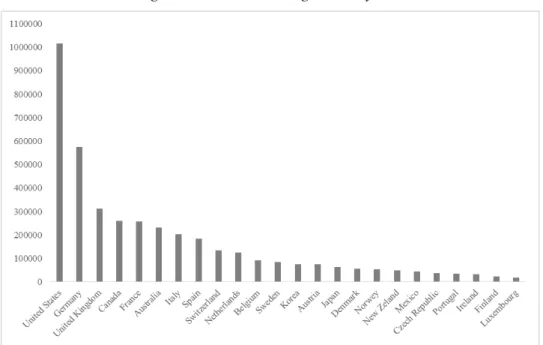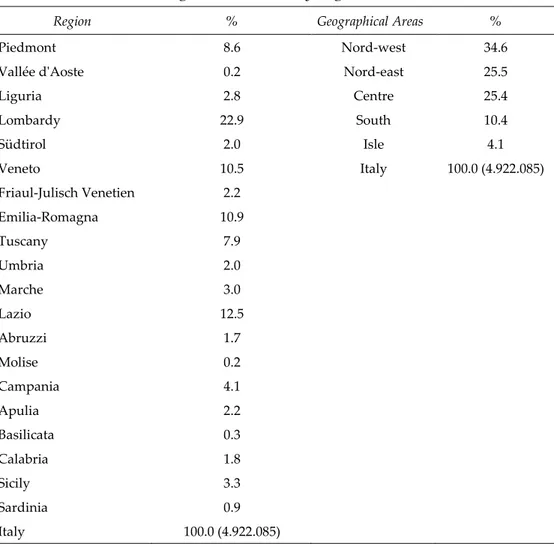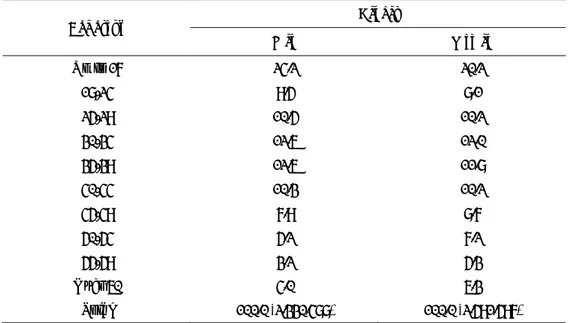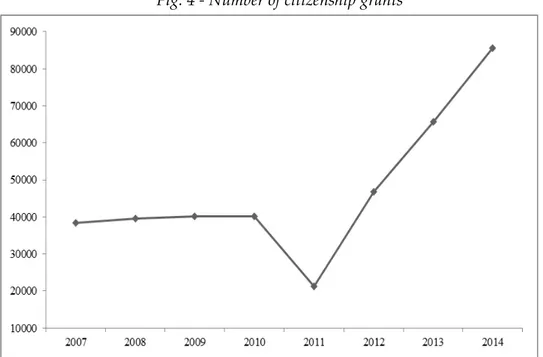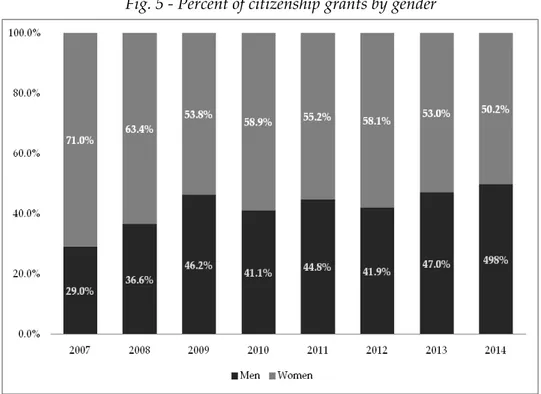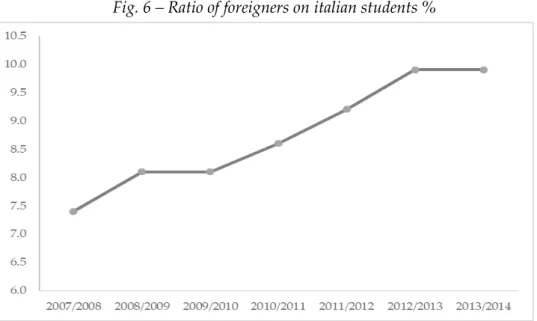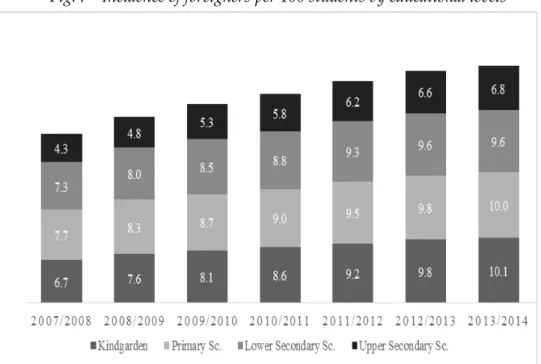GABRIELLA D'AMBROSIO*&VERONICA PASTORI** How to cite
D’Ambrosio, G. & Pastori, V. (2018). Some Indicators for the Analysis of Interculturality in Italy, Journal of Mediterranean Knowledge-JMK, 3(1), 37-60. DOI: 10.26409/2018JMK3.1.03
Retrieved from
http://www.mediterraneanknowledge.org/publications/index.php/journal/issue/archive
1. Authors’ information
* University “La Sapienza” of Rome, Italy
** National Institute for the Evaluation of the Education System, Italy
2. Authors’ contact
Gabriella D’Ambrosio: [email protected] Veronica Pastori: [email protected]
Article first published online: June 2018
-Peer Reviewed Journal
Additional information about Journal of Mediterranean Knowledge-JMK
GABRIELLA D'AMBROSIO*&VERONICA PASTORI** *University “La Sapienza” of Rome, Italy
**National Institute for the Evaluation of the Education System, Italy
Abstract
The goal of this study is the analysis, through secondary data deriving from the main national sources, of migration’s phenomenon in Italy from 2007 to 2014. In particular, the purpose of paper is the description of interculturality focusing the attention on four specific dimensions of the daily life, like citizenship, education, labour market and marriage. Each of these offers a set of statistical indicators useful to observe the integration of migrants in Italy.
So, from this research, it will emerge actual role of Italy in European migration context with the hope that a real politic of inclusion, based on dialogue and interaction among
autochthonous and foreigners, will be raise in our country where the foreign presence, in
the time span of seven years, is increased by 67.5%. For this reason, the recognition of each individual, independently by national membership, is a fundamental element for builing a global community.
Keywords: Secondary Data, Immigration, Integration
Introduction
In the last years, Italy is been characterized, for its geographical and cultural position, to be one of the European countries with the largest number of foreign residents (Organization for Economic Co-operation and Development [OECD], 20141): more specifically, from the end of the 1970s and early 1980s, it experienced, as with other southern European countries, a «turnaround» from an emigration to an immigration society2.
1 Indeed, the transfers from abroad or requests of residence’s permits by migrant citizens are increased.
2 In more detail, by echoing the words of Bruno Riccio (2000), "immigration into Italy is better understood as a post-industrial phenomenon. There were social changes, often attributed to immigrants, which are instead connected with the broader economic framework receiving such immigrants. These changes from the earlier industrial migration made immigration into Italy a model case, because of the power of its tertiary sector and the
For this reason, the aim of this paper is analyze migration’s phenomenon in Italy particularly from 2007 to 2014, using secondary data from some national sources (National Institute for Statistics, Ministry of Interior, Ministry of Education and Chamber of Commerce). The choice to carry out a cross-section research3 to study the dynamics of immigration, in relation to these specific years, is motivated, on the one hand, for the EU enlargement in 2007 (with the addiction of Romania and Bulgaria) and, on the other hand, for the statistical-demographic data availability.
After the description about the immigration in Italy, this study explores four specific dimensions of the daily life (citizenship, education, labour and marriage) and offers a set of statistical indicators useful to observe the process of interculturality.
1. Theorical Framework of Immigration in Italy
The human migration is a global phenomenon that characterizes and changes our society. When people move, some elements of the pact of coexistence are questioned: in fact, if on one hand the immigrants are a great resource for the development of the host country, on the other hand they involve the institutions to ensure efficient policies of social integration and promote equal opportunities for new citizens. Nevertheless, nowadays, the achievement of these objectives is increasingly difficult if we only think about the interactive nature of this phenomenon4: the migration is a process impossible to define and it's continuously revised and socially builded in the interchange with the host society.
informal or shadow economy requiring an unorganised labour force prepared to accept any kind of working conditions" (p. 54).
3 In cross-sectional research, measurement occurs once for each unit in the study and their measurement applies to a single time interval of period (Menard, 2002; Lewis-Beck, Bryman & Liao, 2004).
4 Marsella & Ring (2003) wrote that “in all instances, the lives of both the migrants and those who arrived before them are changed by migrations, for migration is an interactive process - both migrant and host are permanently altered by the encounter. A new social and environmental ecology emerges. Values, ideas, and diseases are exchanged, and eventually so are genes” (p. 4).
But what does it mean to be "a migrant"? For the United Nations, an individual is a migrant when three specific aspects coexist:
- the crossing of a national border and the consequent shift in another country;
- the host country has to be different from the one in which the subject was born;
- the prolonged stay in the receiving country (minimum one year). Thus, migration, as claimed by Ambrosini (2005), known italian sociologist, “should be viewed as processes, a dynamic evolution which involves a series of adaptations and changes over time, and as systems of relations that relate the starting, the transit and the destination areas, involving a plurality of actors and institutions: the authorities of the country of origin, those of the countries crossed, those of receiving countries, regulatory systems governing the movements, the landmarks of migrants in settlement sites, the relatives left at home, ways that ensure connections and communications, and others” (p. 18).
If we want to investigate why a person decides to emigrate, we have to separate microsociological explanations from macro-sociological/ structuralist one: the former, the migratory behavior is the result of subjective choices (for example, they could be based on individual calculations of utility maximization5) so the migration is an aggregate effect generated by individual decisions; the latter, the migration is explained starting from social inequalities that exist among different areas of the world: therefore, many families or just one spouse has to leave the native land looking for a better life (from this point of view, the need to emigrate is connected with some major structural factors like poverty, lack of work or low employment remuneration, overpopulation in third-world countries, wars, famines and oppressive regimes6).
With reference to the nation taking into consideration, we can note that, observing National Institute for Statistics data (ISTAT, 2011), Italy has become an immigration country expecially from 2000: in that year, the
5 This explanation is based on neoclassical economic theory and cost/benefit rationality. 6 At this regard, we can speak about push and pull factors. With words of Codrington (2005) “the factors that encourage a person to move can be divided into push factors and pull factors. Push factors are forces that send a person away from an area. Pull factors are the forces that attract a person into a certain area” (p. 452).
number of immigrants was 1.388.153 and this value is nearly tripled in the space of ten years (3.648.128).
According to recently OECD data (2014), Italy is at 7th in the world ranking about permanent immigration inflows7 (204.100) and in Europe it is at 4th after Germany (574.500), United Kingdom (311.500) and France (258.900) (Fig. 1).
Fig. 1 - Permanent immigration inflows
Source: elaboration on OECD, 2014
Thus, Italy has a primary role in European migration context. With reference to the foreign residents, their presence on italian territory is equal to 4.922.085 units (ISTAT, 2014).
In particular, the highest concentration of foreign residents is in Centre-North Italy (Tab. 1) – together Centre-North-East, Centre-North-West and Central areas
7“Permanent immigrant inflows cover regulated movements of foreigners considered to be settling in the country from the perspective of the destination country. Then cover regulated movements of foreigners as well as free movement migration” (OECD, 2014). The indicator is measured by standardization for cross-country comparison of numbers of permanent inflows.
collect 85.5% of those8 – and, in detail in Lombardy (22.9%), Lazio (12.5%), Emilia-Romagna (10.9%) and Veneto (10.5%).
Tab. 1 – Foreign residents in Italy, region and areas (%)
Region % Geographical Areas %
Piedmont 8.6 Nord-west 34.6
Vallée d'Aoste 0.2 Nord-east 25.5
Liguria 2.8 Centre 25.4 Lombardy 22.9 South 10.4 Südtirol 2.0 Isle 4.1 Veneto 10.5 Italy 100.0 (4.922.085) Friaul-Julisch Venetien 2.2 Emilia-Romagna 10.9 Tuscany 7.9 Umbria 2.0 Marche 3.0 Lazio 12.5 Abruzzi 1.7 Molise 0.2 Campania 4.1 Apulia 2.2 Basilicata 0.3 Calabria 1.8 Sicily 3.3 Sardinia 0.9 Italy 100.0 (4.922.085)
Source: elaboration on ISTAT, 2014
8 According to Parati (2005), “that separation between North and South is therefore grounded in an economic superiority of a European North that has also been achieved through processes of migration that are constitutive of the European identity. This is particularly relevant to the case of Italy, whose political, economic, and historical identity is intrinsically connected to present and past migrations” (p. 45).
These aggregated data show the connection between the presence of immigrants and the basic necessities of the local economic systems: in the principal cities of the metropolitan areas and within the touristic areas, the recruitments concern the lower tertiary and the construction industry. However, it is necessary to underline that these percentages are calculated on italian total and without considering the amount of italian citizens in each territory (this type of analysis is presented and described further).
If we consider origin’s countries of foreign residents, it’s possible to show that Romania is at the first place with 22% (Tab. 2). This outcome doesn’t amaze after the EU enlargement in 2007, year characterized by addiction of Romania9 and Bulgaria into European partnership.
After Romania, the other origin’s countries are Albania (10.1%), Morocco (9.2%), China (5.2%) and Ukraine (4.5%). Furthermore, there is the Poland within the group of European Union.
Tab. 2 - Origin's countries of foreign residents in Italy (%)
Top five (in general) Top three in EU Top three extra-EU
Romania (22.0%) Romania (22.0%) Albania (10.1%) Albania (10.1%) Poland (2.0%) Morocco (9.2%) Morocco (9.2%) Bulgaria (1.1%) China (5.2%)
China (5.2%) Ukraine (4.5%)
Source: elaboration on ISTAT, 2014
With regard to individual characteristics of migrants, we are going to describe some socio-demographic variables related to foreign residents in Italy in 201410.
9 Actually, the immigration from Romania started in the early Nineties due to the political context (more specifically, Ceausescu’s dictatorship), but the only ones that could emigrate were people of Jewish and German origin, thanks to agreements amoung the Romanian Government, Israel and the German Federal Republic. So, after the transition from State economy to Market economy, Italy, yet known for the presence of italian businessmen in Romania, becomes a privileged destination.
First of all, we analyze gender: the following chart shows that the majority of migrants are women.
In the classic immigration studies the central subject is always been the man. Women, when they were taken into account, are "women who follow the mate", people with little autonomy and influence over others. Only in recent years, women are recognized as protagonists of migratory processes: in 2014, 52.7% (2.591.597) of immigrants are women and the remaining 47.3% are men11 (2.330.488).
Fig. 2 – Percent of foreigners by gender
Source: elaboration on ISTAT, 2014
Moreover, a high percentage of women can be explained with reference to ageing of the italian population, in particular the social assistance has
11 Migrants in Italy live mainly in North (59.4% women and 60.8% men). Then the 25.7% of women live in Central Italy and the 14.9% in Southern Italy while 25% of men live in Central Italy and the 14.2% in Southern Italy. The low percentage of foreign women in the South is explained with reference to the labour market, as mentioned before. One need only think, for example, that in 2014 the percentage of unemployed women in the South of Italy was 43.3% against 36.3% in the North (the remain percentage refers to the Central Italy) (Source: ISTAT).
required import of caregivers from abroad (especially, ancient assistant and domestic worker): from this point of view, the migrant women are reconfirmed in the traditional role as custodians of family values and as links to the home culture (Palanca, 1999).
With regard to age group, women are mostly from up to 17 years (20.2%) or from 30 to 34 (12%) while men are up to 17 years too (24.2%) or from 30 to 34 or from 35 to 39 years (12.6%).
Tab. 3 - Percent of foreigners by age group
Age group Gender
Men Women Up to 17 24.2 20.2 18-24 9.5 8.1 25-29 10.5 10.2 30-34 12.6 12.0 35-39 12.6 11.8 40-44 10.3 10.2 45-49 7.9 8.7 50-54 5.2 7.2 55-59 3.2 5.3 Over 60 4.0 6.3 Total 100.0 (2.330.488) 100.0 (2.591.597) Source: elaboration on ISTAT, 2014
It is interesting to see how, starting from the analysis of this variable, migrants that are up to 17 years ask for a allowed for long-term. Indeed, almost 29% of long-term permits are issued to young immigrants: it's increasing, so, the number of "second-generation immigrants", children born in Italy that are sons of immigrants or sons of a mixed couple (one parent immigrant and one italian). The so-called "immigration children" are a key issue that mark the passage of one type of migration to another: from temporary experiences to definitive settlements. This is connected to a new way of “rethinking immigration” (Suárez-Orozco & Suárez-Orozco, 2001) given that if, in the past, immigrants left their families with hope to came
back, nowadays, immigration is a “collective” phenomenon rather than “individual” since ever more families leave their home country.
As mentioned previously, Italy has been characterized as a country of immigration expecially from 2000 and, if on one hand, the foreign presence is growing and distributed throughout the nation, on the other hand people who come here want to have an effective stabilization. To demonstrate this, we analyze the statistical indicator for the type of allowed12.
Fig. 3 – Percent of foreigners by type of permit
Source: elaboration on ISTAT, 2014
With regard to the type of permit, in 2014 most of the permits issued are for long-term (effective from January 2007): the main feature of this type of permit is to be "open-ended" so the period in which migrants can stay in Italy is indeterminate. Analyzing the data in Fig. 3, we note that the allowed for long-term represent 56.3% of the total (the permits with expire are 43.7% of total13).
12 It is worth specifying that the variable "type of permit" refer only to non-EU citizens. 13 Crossing this variable with marital status, we can note that 56.6% of immigrants are unmarried while 42.2% are married. Residual percentage (about 1%) is for divorced or widowed people.
The reasons for ask a permit for non-UE citizens are: family reasons (40.8%), work (23%), humanitarian reasons (19.3%), study (9.8%) and others (7.1%).
In conclusion, in this section, we have drawn a frame for the migration in Italy in all its complexity. Faced with an increasingly phenomenon is, of course, desirable to integrate the foreigners in our national context in order to create cooperation in building a better Italy: in fact, the real inclusion policy is to valorize the capabilities of all its citizens, whether native-born or immigrants from other countries, and overcome the discrimination.
Through valid initiatives and an effective review of wrong images and degrading representations, we can obtain the recognition of similarities among populations and the mutual respect of the principle of equality.
2. Interculturality Concept and its Dimensions
Once arrived in the host country, the foreigner doesn't find the easy life he had imagined but, conversely, he has to live and struggle with the new challenges and the new culture of reference. From this point of view, for example, he has to overcome different obstacles especially in the face of hostility of a society unprepared to accept "black italians", "muslims" or "italians with almond-shaped eyes". In the words of Harman (1988) “strangeness is no longer a temporary condition to be overcome, but a way of life. The group, once formulated as homogenous and self-contained, does not clearly exclude the stranger. Rather, it is the one who is unfamiliar with the language of strangeness [...] who becomes an anomaly when overtures of membership orientation are made in a «world of strangers»” (p. 44).
Therefore, immigrants can be included in a "double bind", a notion conceived by the famous polish sociologist Zygmund Bauman: if on the one hand they are induced to escape from their homeland, on the other hand their access and social inclusion is denied in the destination country. As Bauman (2007) writes, “do not change place; lose their place on earth and are catapulted into a place that there isn't” (p. 49).
So, the general condition of immigrants is characterized by nostalgia of the country of origin and by the uncertainty of life. Continuing with Bauman (2007), it's possibile talk about "future inmates" who “are stripped
of every single element of their identity except one: that they are refugees with no place to stay, no function and no documents. Inside the fence of the camp, the refugees are pressed by a faceless mass and their access is denied for the most basic things which refer to identity” (p. 43).
This hardness of foreigners to live in a unkwown land is strengthened by the difficulty of finding people who accept the difference and, with the aim of helping foreigners in the long process of integration, don't raise human barriers and try to build a "community of universal communication" (Bartholini,2008).
Taking, then, the concept of stigma by Erving Goffman (1963), it's easy to see how, in our globalized world, the immigrant is stigmatized and, very often, it happens that the natives have, for them, closing feelings (like indifference, worry, suspicion, fear) or feelings of exclusion. In this connection, Bauman says that are two impressive phenomena in our contemporary society: on one hand the so-called mixofilia, on the other hand the mixofobia (Bauman, 2007). With the first word the polish sociologist indicates a process by which immigrants become increasingly unknown to the members of the group of natives (in this case, the dialogue and interaction with them vanish); the mixofobia is the fear towards foreigners (in this case, the cohabitation becomes complicated and the minimization of contact will intensify the pressures to segregation). Not only that: these feelings coexist in every town and, in detail, within each of the city's inhabitant.
However, in order to build a global and united society, we have to avoid discriminatory attitudes and start to live with each other: in this sense, our cities should be seen as "laboratories" where the inhabitants of a overcrowded planet learn the ways to appreciate the difference. Furthermore, only through recognition of the other, it's possibile build up a "humanity's acceptance of others of mankind" (Bartholini,2008) and we can share an enlarged citizenship (Kant, 1788).
For this reason, the concept of interculturality becomes fundamental in this analysis. This notion, according to Walsh (2002), is “based in the necessity of constructing relations between groups, as well as between practices, logics and different knowledge, with the urge of confronting and transforming the power relations (including the structures and institutions of society) that have naturalized the social asymmetries” (p. 24).
The prospective of openness, discussion and dialogue among different cultures and human lives sees, therefore, the identity number as a treasure. So, interculturality rejects the idea that culture is a monolithic phenomenon: it represents a set of shared, contested, negotiated narration.
After specify what mean interculturality, we can explain the methodological base of our work.
Starting from Lazarsfeld’s paradigm and process of operationalization (1958), after representation and specification of concept of interculturality, we identify some dimensions, four specifically, of this concept.
These dimensions refer to more important daily life’s areas in which everybody is integrated and these are: citizenship, education, work and marriage. Each of four dimensions is analyzed by construction of some indicators. In this way, it’s possible describe phenomenon of inter-culturality in italian context from 2007 to 2014.
To achieve main goal of research, we use secondary cross-section data collected by national sources as ISTAT, Ministries and Chamber of Commerce.
The indicators are based, mainly, on odds between foreigners and italians and their descriptions are given in the following sections.
Citizenship
The statistical indicator of citizenship grants is, certainly, among the most important in order to measure the integration of foreigners in the italian context. It doesn’t stop there because acquisition of citizenship status provides, for immigrants, a measure of security from this encroachment on their rights (Aptekar, 2015).
Always, the competence about citizenship is of the Ministry of Interior who, in the law no. 91/199214, has established that it may be acquired under the following specific conditions:
- by descent (principle of "ius sanguinis");
- by birth on italian territory (principle of "ius soli"); - by marriage to an italian citizen;
- in case of naturalization15;
14 This law reassesses the importance of individual intention in the acquisition or loss of citizenship and recognizes the right to hold more than one citizenship simultaneously.
- granting of italian citizenship pursuant to special laws.
Now, we can observe (Fig. 4) that, in recent years, the number of citizenship grants to foreigners in Italy has more than doubled (from 38.466 in 2007 to 85.526 in 2014). In particular, from the last four years analyzed, it’s possible underline an increment in a sustainable manner (while from 2007 to 2010 the data remains approximatly stationary16).
Fig. 4 - Number of citizenship grants
Source: elaboration on Ministry of Interior, 2007-2014
15 It’s possible required legal residence in Italy for 3 years for descendents of former italian citizens up to the second degree and for foreigners born on italian soil; 4 years for citizens of a European Union country; 5 years for Stateless persons and refugees, as well as for adult foreigners over the age of 18 adopted by italian citizens; 7 years for children adopted by italian citizens before the entry into effect of Law no. 184/1983; 10 years for non-EU citizens.
16With regard to 2011, probably the anomaly of this value is due to the political context of this year and, in particular, about the discussion of a law aimed at simplifying the procedure for obtaining citizenship.
Furthermore, if we want to go into more detail in our analysis, we can note that the highest number of citizenship grants is for the female gender (Fig. 5 confirms that the most stabilization in Italy is by immigrant women).
Fig. 5 - Percent of citizenship grants by gender
Source: elaboration on Ministry of Interior, 2007-2014
With respect to geographical distribution, we know that the italian regions where there is the largest number of citizenship grants are in the North, probably for more job opportunities (the data, therefore, confirms the empirical evidence analyzed in the previous section).
In conclusion, the study about the citizenship grants is, from a sociological point of view, undoubtedly very important in the same way as the theme of belonging and rights in immigration societies: think, today, the practice of citizenship is the only way through which communities assert their cultural identity and values, reiterating the duty of the citizens to respect them (Zanfrini, 2007).
Education
Second dimension considerated is education because the school is an important channel for the socialization and integration of foreigners. Children and teenagers spend most of their time at school, so the foreign presence is an occasion of mutual knowing, of discovery of other cultures, their characteristics and it’s a way to guide toward intercultural conscience. In the seven school years examinated17, overall, the ratio of foreign students on italian students is increased by more than two percent points (Fig. 6).
Fig. 6 – Ratio of foreigners on italian students %
Source: elaboration on Ministry of Education, University and Research, ss.yy. 2007/2008-2013/2014
Focusing the attention on the educational levels (Fig. 7), we note, observing data from Ministry of Education, that the progressive increase concernes each level.
In particular, the change in the longer term (2007-2014) involves especially kindergarten (3.4%), whereas the average increase is of 0.6
17 In this analysis is excluded the data about tertiary education for their peculiarities. For example, there are specific programms aimed at supported the international geographical mobility of the students.
percentage points for this level and of about 0.4 for the others. This data is very important if we consider that it is easier build a multicultural conscience for children because they are still far from being prejudiced about diversity. On the contrary, grewing become more difficult, because it means to call into question themselves.
Moreover, in general, the highest percentages relate to the first three levels of education. This general increase of foreign presence into the school system is an important aspect for the interculturality: by the close contact with other nationality from early childhood, it’s possible to teach the respect for other, know their habits and tradition.
Fig. 7 - Incidence of foreigners per 100 students by educational levels
Source: Ministry of Education, University and Research, ss.yy. 2007/2008-2013/2014 Work
The third dimension that we want to study refers to the labour market. The last decade (2004-2014) has seen an increase in the number of foreign workers, so we evaluate this an essential aspect of interculturality. As a matter of fact, looking at data by ISTAT, in 2004 the number of foreign workers was 965.112 and in 2014 this number was more than doubled
(2.294.12018). However, relatively to the working environment, we analyze only self-employment. The reasons of this choice are mainly two: 1) the availability of all the information considered important for the purpose of this research; 2) the peculiarity presence of the self-employer foreigners into working system19.
Generally, from 2007 to 2014 the foreign self-employments are incresed, approximately, three percentage points (from 6% to 8.7%) (Fig. 8).
Fig. 8 – Foreigners on Italian self-employer % odds
Source: elaboration on Chamber of Commerce, 2007-2014
In particular, this growth concerns business ownership (from 9.1% to 14.9%) whereas the others categories remain roughly stationary (Fig. 9): foreign manager and partner increase, respectively, of 1.2 and 1.6
18 In terms of percentage variation there has been a +137.7% increase.
19 For example, in Italy since 2008, it is established MoneyGram Award, a program dedicated to business of foreigners: every year, the program awards five business people, each for a feature like “profit growth”, “social responsability” or “youth entrepreneurship”.
percentage points on italian in the same positions. The other positions increase only 0.3% in seven years.
Fig. 9 - Foreigners on Italian self employed % odds
Source: elaboration on Chamber of Commerce, 2007-2014 Marriage
Among different social transformation affecting Italy, mixed marriage is an event that, in recent years, has become increasingly important. The "mixed family" is characterized, in fact, to the membership of cultural and different racial groups: so, this is a social phenomenon resulting by the increase in a rate of immigration. Thus, there is a very strong link between immigration and mixed couple: once again, the statistical indicator about mixed marriages shows that the immigration is becoming, with the passing years, a structural fact, a social component that slowly continues to change the ethnic, cultural and religious settings of our italian cities. For this reason, mixed marriage is defined by Merton (1941) “as marriage of persons deriving from those different in-groups and out-groups other than the family which are culturally conceived as relevant to the choice of a spouse” (p. 362).
From this point of view, men and women coming to Italy from foreign countries are not limited, therefore, to carry out a professional work but
also live the important moments of socialization among them like, for example, a romantic relationship with an autochthon. A relationship that creates a strong element of stabilization in new territory: the mixed marriage becomes absolute symbol of integration and intercultural of foreigner within the host society.
The average percentage of mixed marriages in Italy is about 16% (Fig. 10).
Fig. 10 – Mixed marriages on Italian marriages % odds
Source: elaboration on ISTAT, 2007-2014
The irregular data of 2010 depends on overall decrease in the number of marriages. From 2007 to 2010 the percent variation of italian marriages is -10.7% while that of mixed marriages is -27.4%.
Analyzing the ISTAT data we can see that, in recent years, there has been an increase of mixed marriages especially in the case whereas an italian man marries an immigrant woman (51.1% in 2007 and 56.3% in 2014). In contrast, the percentage of couples characterized by italian bride and foreign spouse is stable for all the years considered (around 15%) while the percentage relative to the couples formed by both foreign citizens is settled at about 30% of mixed marriages20
20 With regard to the regions, the majority of mixed marriages can be found primarily in North Italy.
Fig. 11 – Mixed marriage by type of couple
Source: elaboration on ISTAT, 2007-2014
With regard to the nationality of the spouses, there are many differences depending on whether it is foreign bride or foreign groom. In the first case, italian men marry women from Eastern Europe (specifically from Romania and Ukraine21); in the second case, italian women marry migrants from Africa (mainly from Morocco) and Albania22. Referring to couples in which both spouses are foreigners, in most cases they come from Romania and China23.
Regardless the type of mixed marriages, we can observe that most of these are celebrated according to a civil ceremony rather than religious. From Fig. 12 it is possible to note that from 2007 to 2014 civil marriages
21 The number of marriages celebrated from 2007 to 2014 between italian groom and romanian woman is 20.808 while 13.105 are marriages celebrated between italian groom and a ukrainian woman.
22 The number of marriages celebrated from 2007 to 2014 between italian bride and maghreb is 5.788 while the marriages with a migrant from Albania are 3.052.
23 In fact, during the years taken into consideration, they were been celebrated in Italy 7.880 marriages between two romanian citizens and 4.704 marriages between two chinese citizens.
accounted for nearly 85% of the unions while the remaining 15% refers to ties sanctioned by religious rite.
Fig. 12 – Mixed marriage by rite
Source: elaboration on ISTAT, 2007-2014
In addition, almost 70% of marriages between two spouses of different nationalities are first marriages while the remaining percentage refers to second marriages (Fig. 13).
Fig. 13 – Mixed marriage by first and second marriage
To sum up, the mixed marriage can be seen as a structural index and secure gateway to a complete assimilation into the host society: they represent an element of social vitality in the particular historical moment that crosses Italy. So, a mixed marriage is an item that is certainly a factor of integration, confirming the idea that immigrants are more and more stabilized in our country and that their contribution is crucial to the establishment of new multiethnic and multicultural families.
Conclusion
The analysis in this paper has highlighted the changes in the italian context that have occured after the increase in the rate of immigration.
Through the study of the four dimensions we had observed the constant presence of foreigners. More specifically, our analysis of interculturality in Italy underlines two important phenomena: on the one hand, increase of foreigners on italian territory and, on the other hand, the stabilization of this people confirmed, by way of illustration, from the number of acquisitions of citizenship, the remarkable presence of second generation (mostly in education system) and from many self-employed foreigners into working system.
It's possibile to say that, in a multicultural country, only thanks to the presence of foreigners, that we can build a truly harmonious society, contrary to the prejudices and racial intolerance, whose goal is to share and respect for diversity and ethnicity of others. Thus, interculturality can be considered the first step towards a process of re-appropriation of identity, which doesn't require either the difference either equality among individuals but the similarity, which leads to a citizenship of diversity.
In this regard, evoking the prospect outlined by Bartholini, Italian sociologist, we have to work for an universal recognition of every human being and his rights through the creation of a "trascendent identity"
(Bartholini, 2008) that can indicate the way for a post-global project of
cohabitation between strangers who respect each other for their individual dignity.
To conclude, it is possibile create a social structure based on cooperation (tolerance), in which individuals base their relations on mutual acceptance of diversity and of their immune peculiarities.
References
Ambrosini, M. (2005). Sociologia delle migrazioni. Bologna: Il Mulino.
Aptekar, S. (2015). The road to citizenship. What naturalization means for immigrants and the United States. New Brunswick-New Jersey-London: Rutgers University Press.
Bartholini, I.(2008). Uno e nessuno. L’identità negata nella società globale. Milan: FrancoAngeli. Bauman, Z. (2007). Modus vivendi. Inferno e utopia del mondo liquido. Rome-Bari: Laterza. Codrington, S. (2005). Planet geography. Sydney: Solid Star Press.
Goffman, E. (1963). Stigma: notes on the management of spoiled identity. New York: Simon & Schuster.
Harman, L.D. (1988). The Modern Strainge: on Language and Membership. Berlin-New York- Amsterdam: Muton de Gruyter.
National Institute for Statistics. (2011). Italia in 150 anni. Sommario statistiche storiche. 1861-2010. Rome: National Institute for Statistics.
Kant, I. (1788). Kritik der praktischen Vernunft.
Lazarsfeld, P.F. (1958). Evidence and Inference in Social Research. Daedalus, 87, 4, 99-130. Lewis-Beck, M.S., Bryman, A., & Liao, T.F. (2004). The Sage Encyclopedia of Social Science
Research Methods. Thousand Oaks: Sage Publications.
Marsella, A.J., & Ring, E. (2003). Human Migration and Immigration: An Overview. In L.L. Adler & U.P. Gielen (Eds.), Migration. Immigration and Emigration in International Perspective (pp. 3-22). Westport-London: Praeger.
Menard, S. (2002). Longitudinal Research. Thousand Oaks, CA: Sage Publications.
Merton, R.K. (1941). Intermarriage and the social structure: fact and theory. Psychiatry. 4, 3, 361-374.
Organisation for Economic Co-operation and Development. (2014). Is Migration really Increasing?. Retreived 28 May 2017, from http://www.oecd.org/berlin/Is-migration-really-increasing.pdf.
Palanca, V. (1999). Guida al pianeta dell’immigrazione. Rome: Editori riuniti.
Parati, G. (2005). Migration Italy. The Art of Talking Back in a Destination Country. Toronto-Buffalo-London: University of Toronto Press.
Riccio, S. (2000). The Italian Construction of Immigration: Sedentarist and Corporatist Narratives Facing Transnational Migration in Emilia-Romagna. In I.M. Greverus & R. Römhild (eds.), The Mediterraneans Transborder Movements and Diasporas (pp. 53-74). Münster-Hamburg-Berlin-London: LIT Verlag.
Suárez-Orozco, C. & Suárez-Orozco, M. (2001). Children of Immigration. London: Harvard University Press.
Walsh, C. (2002). Interculturalidad, reformas constitucionales y pluralismo jurídico. In J. Salgado (ed.), Justicia Indigena: Aportes para un debate (pp. 23-36). Quito: Ediciones Abya-Yala and Universidad Andina Simón Bolivar.
Zanfrini, L. (2007). Cittadinanze: appartenenza e diritti nella società dell’immigrazione. Rome-Bari: Laterza.
